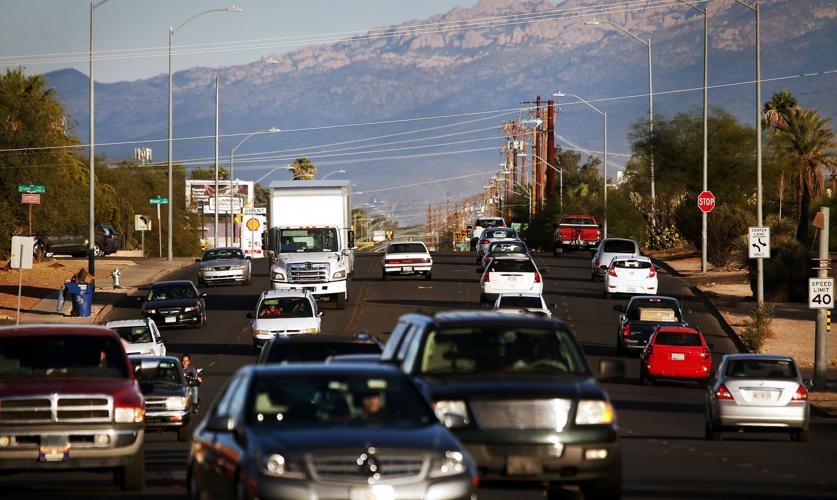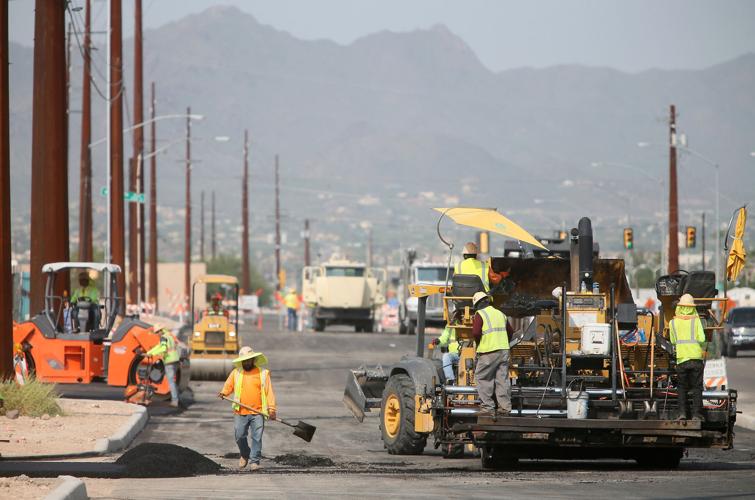As anyone who uses the thoroughfare between North Stone and Park avenues can tell you, the second phase of the massive Grant Road Improvement Project is well underway, though it had a somewhat late start.
However, the next four phases, which are grouped into two pairs and will ultimately widen the road all the way to North Swan Road, could be significantly more delayed.
Phases three and four — between North Palo Verde Boulevard and Swan — were previously slated to begin sometime between 2018 and 2020, a range included on the project’s website as recently as March. That has now been moved to 2023 to 2025. Similarly, phases five and six, roughly between North Mountain Avenue and North Country Club Road, were expected to begin between 2021 and 2023 and are now expected to begin between 2026 and 2028.
So, why?
“Pure cash flow within the RTA,” is how Daryl Cole, director of Tucson’s transportation department, answered that question from the Road Runner.
Initial revenue estimates for the voter-approved RTA sales tax were around $2.1 billion through 2026, but those estimates were done several years before the Great Recession. On top of the years-long ripple effects of the recession, consumption patterns have also shifted toward untaxed services, together spelling significantly lower sales tax receipts. A February analysis from the University of Arizona’s Eller College of Management put the likely total revenues at $1.6 billion, nearly a full quarter shy of the original forecast.
It was in this context of declining revenues that the RTA’s board — made up of representatives of all the RTA’s member jurisdictions — decided to adjust the five-year transportation improvement program to better match those diminished revenues, according to minutes from the December meeting and the RTA’s Jim DeGrood.
The possibility of again going out to bond, which would provide more money for projects in the near term but larger debt service costs in the long run, was discussed, but the board ultimately — and unanimously — decided to adopt a pay-as-you-go plan with the possibility of issuing debt construction-ready projects on a “case-by-case” basis.
As Cole pointed out, paying debt service on bonds “effectively reduces the overall amount of funding for projects within RTA plan.”
Cole said the city and other jurisdictions worked with the RTA for roughly six months to reconfigure the transportation improvement program, and “due to the funding cash-flow constraints, projects were delayed within the RTA plan.”
Though the estimated start time for the final Grant phases now extend beyond the 20-year RTA period, Cole said that “at this point in time” the plan is to finish it.
Property acquisitions are proceeding for phases three and four and, “upon completion of phases three and four, we will continue to design and procure property in order to complete the final … phases,” Cole wrote in emailed responses to the Road Runner.
“I don’t think the city lightly considered what it had to do with Grant Road, in fact I know it was a very painful decision on their part,” DeGrood said. “They prioritized the Broadway project (Camino Seco to Houghton Road) and the Downtown Links project as being those projects that were ready to build and were their priority projects.”
So, what do those delays mean on the ground? The Road Runner spoke to a resident and business owner along the corridor to get an idea.
“If somebody is subject to acquisition, that means that for the foreseeable future they are in limbo, they probably can’t even sell their house,” said Bob Schlanger, a member of the Jefferson Park neighborhood association board. “So, if they want to move, if they want to retire, move somewhere else, whatever they want to do, they’re stuck.”
City Councilman Steve Kozachik, whose ward encompasses much of the Grant project, agreed with Schlanger and said blight could result from the delays, as could decreased investment along the corridor. While saying he understood the fiscal rationale, Kozachik said there could be political fallout from the schedule changes. He suggested rethinking some RTA projects, like the Broadway expansion, and shifting money to projects like Grant.
“What would be more honest, let’s go back and look at what we said to the voters in 2006 and see if it still makes sense,” he said.
Jim Hogan, president of the Hogan School of Real Estate, along phases three and four of the project, said he hadn’t been told about the delays, even though he’s on the Grant Road Task Force representing businesses. He missed the October task force meeting where it was announced and told the Road Runner he wished the change had been communicated better to business owners along Grant. Having that knowledge could have impacted leases and other business negotiations, he said.
But he also said that the delay could actually encourage some building investment, or at least upkeep. He cited the example of parking lot maintenance at one of his properties, which had been put off when acquisition and construction seemed imminent. Now that it could be another six or more years, it makes more sense.
Cole said that beyond announcing the changes at the October task force meeting, the project’s website was updated and emails announcing the change were sent out on the project listserv.
DeGrood said that a recent bond refinancing will bring some savings and the possibility of accelerating projects that are ready. Discussions with the jurisdictions could come after the start of the year.
But even with the Grant delays, DeGrood said it was always assumed that the project would take much of the 20 years to complete. The RTA has generally stuck to its schedule, a 10-year audit found earlier this year.
“We have to adapt to our financial conditions,” DeGrood said. “Clearly we weren’t planning on the economic recession when we went out to the public with the 2006 plan, we didn’t think we’d be dealing with a reduction of half a billion dollars in revenue over the life of the plan. We’ve adapted, and even under those circumstances we have been delivering on the projects.”
DOWN THE ROAD
Craycroft Road will be closed under Interstate 10 on Monday from 8 p.m. to 5 a.m. Tuesday. Both directions of I-10 will also be reduced to one lane at milepost 268, and loads wider than 11 feet will need to exit at Craycroft. The closures are needed for the Craycroft-I-10 interchange project.





